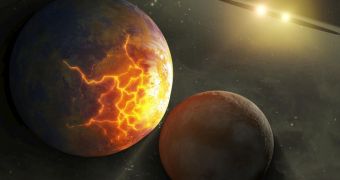In a series of new studies, researchers determined that dual star system are surrounded entirely by cosmic dust envelopes, which may be the remnants of planets that once existed around the celestial bodies.
If that is the case, the group says, then it could be that potential alien lifeforms would have a very difficult time appearing and developing in planetary systems located around such bodies.
The new observations sessions were carried out using the NASA Spitzer Space Telescope, which surveys the sky in infrared wavelengths. It is one of the American space agency's four Great Observatories.
The team that conducted the study did not realize from the start that the dust they saw was from former planets, and so they set out to discover its origin.
“This is real-life science fiction. Our data tell us that planets in these systems might not be so lucky – collisions could be common,” explains scientist Jeremy Drake.
The scientist, who was a member of the research team that conducted the Spitzer investigation, says that the dust may have resulted from impressively-large planetary collisions.
“It's theoretically possible that habitable planets could exist around these types of stars, so if there happened to be any life there, it could be doomed,” Drake adds.
The expert is based at the Harvard-Smithsonian Center for Astrophysics, in Cambridge, Massachusetts, experts at the NASA Jet Propulsion Laboratory (JPL) say.
He is also the principal investigator of a new research paper detailing the findings, which appears in the August 19 issue of the esteemed scientific Astrophysical Journal Letters.
“These kinds of systems paint a picture of the late stages in the lives of planetary systems. And it's a future that's messy and violent,”adds scientist Marc Kuchner.
He is a coauthor of the new investigation, and holds an appointment at the NASA Goddard Space Flight Center, in Greenbelt, Maryland.
The research team says that the discovery of these peculiar dust envelopes around binary star systems is not something that's out of the ordinary.
They say that four such systems have been identified having the same traits as the one Spitzer analyzed recently.
The telescope is managed by JPL for the NASA Science Mission Directorate, in Washington DC. The JPL is managed by the California Institute of Technology (Caltech), also in Pasadena.

 14 DAY TRIAL //
14 DAY TRIAL //